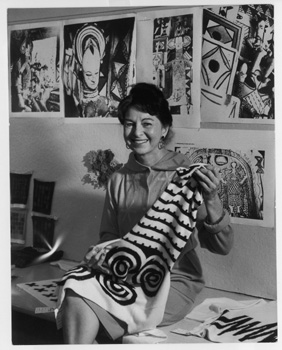
Cashin
with a favorite funnelneck design, photographed against art and
graphics used to inspire her intarsia designs.
Bonnie Cashin for Ballantyne, 1964.
|
real princess stuff:
ballantyne, 1964-1968
Cashin's nomadic character informed her need for professional
diversity as much as her love of travel. Sills agreed that as
long as her designs included an edging or "tracing" of leather
or suede, the firm would manufacture her designs in tweed, jersey,
mohair, fur or canvas, but this did not eliminate collaborations
with other specialized manufacturers. In 1964, she became the
designer for cashmere manufacturer Ballantyne of Peebles, to be
followed by Karl Lagerfeld, longtime designer for Chanel. Cashin
spent as much as six months of each year in Scotland overseeing
cashmere production. Cashin's "modern art" approach to cashmere
featured abstract motifs taken from a mix of sources, including
contemporary painting and African mud sculptures. While she delighted
in posing her radical design concepts to the staid cashmere industry,
and experimenting with the fibers that she described as "all that
delicious, soft, sybarite, luxurious, real-princess stuff," she
admitted that her colleagues "thought I was a little bit wacky."
real-princess
stuff: ballantyne, 1964-1968
 View
exhibit
View
exhibit  |